There appears to have been a church at Châteaumeillant since the early Middle Ages, but the Romanesque church was built as a Benedictine priory in the 11th and 12th centuries. A fire damaged the church in 1152 in the course of struggles between Henry II Plantagenêt of England and Louis VII. The south transept and portions of the nave were reconstructed at this time. This may have resulted in some of the apparent hodgepodge appearance of the interior.
The nave vault was destroyed in 1569, after a fire that was lit by the Huguenot leader Wolfrang, Duke of Deux-Ponts (Zweibrücken) as he ravaged his way across France. Wolfrang paid for his destructions, however. He fell victim to a “quartan ague” a short distance from Limoges. My research finds that the “quartan ague” is “a fever which reoccurred every fourth day; one of the indeterminate febrile ailments of the period, sweating sickness, probably influenza, which could be fatal.”
But the church that we see today is a good representation of the intentions of the original builders. It has a cruciform layout, a bay with five naves and side aisles, with six flanking apsidal chapels in the choir and transepts.
The nave has five bays and is topped with a banded barrel vault. The slightly ogive arcade arches are formed by large piers with engaged columns, split by narrow slender columns that sit atop pedestal bases. All of the columns are topped with capitals. The side aisles also are covered with a banded barrel vault.
The vaulting springs directly from the arcades without the intervention of a tribune, triforium or clerestory level, so the only lighting comes from the side aisles and apse windows.
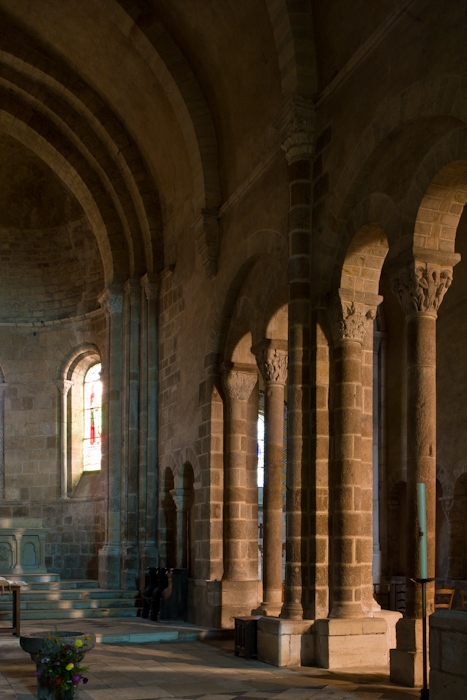
The apse is lit by three windows and is covered with an oven vault. The six echeloned chapels flanking the apse in the transepts eliminate the need for an ambulatory, so there is no hemicycle structure in Saint-Genès. This is very unusual for a church that sits directly on the Santiago de Compostela pilgrimage route.
The photograph of the choir and apse is quite interesting for the feel of the space – the dappled blue light, which is the sunlight coming into the space, gives a certain ethereal sensation.
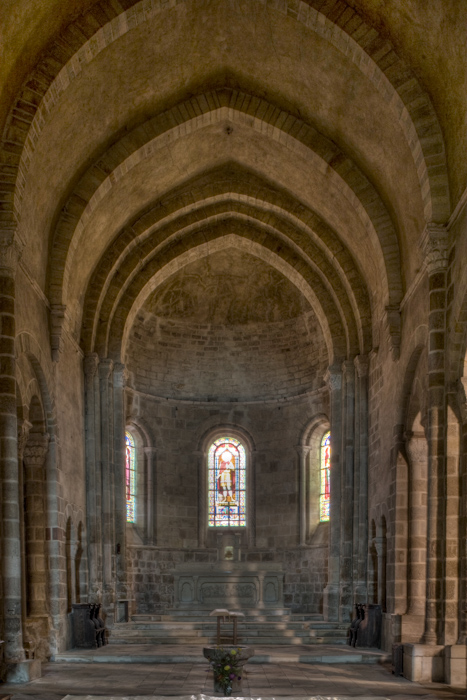
Because of the echeloned chapels, the transept is given increased importance. The visual effect of all the chapels is to create a forest of columns with light coming in from all directions.
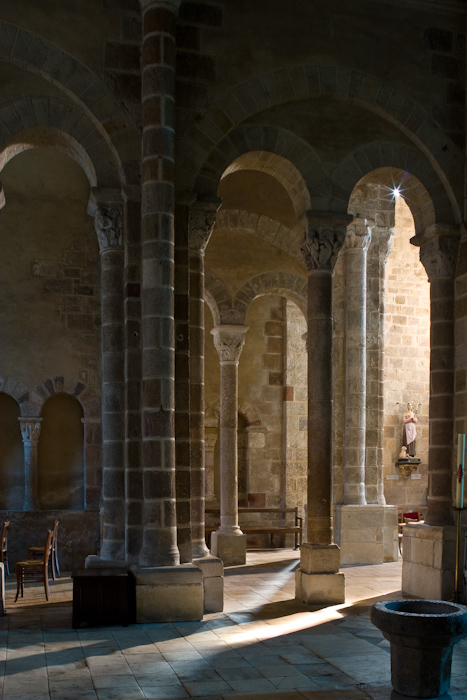
The sculpture of Saint-Genès is quite remarkable. The interior capitals are made of pink sandstone and present a fairly unified ensemble featuring leaves and palms, animals, masks, and human figures.
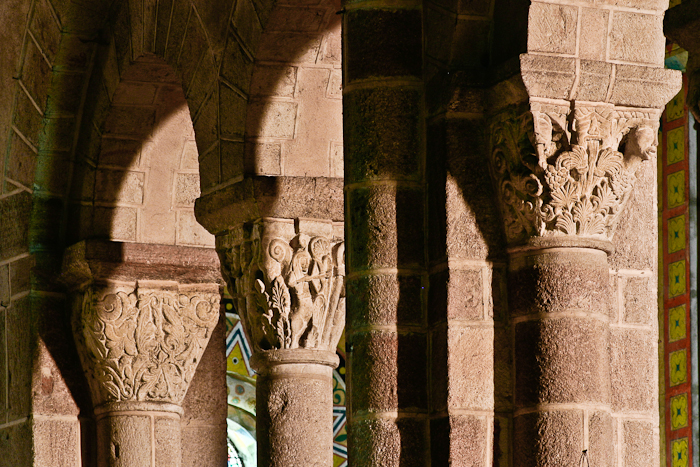
The wonderful capital in the next shot portrays Daniel in the Lions’ Den. At first, because of the bearded and curly-haired figure, we thought it might be Samson fighting the lions, but it became clear that it was Daniel. This is, in my mind, the finest sculpture of the ensemble.
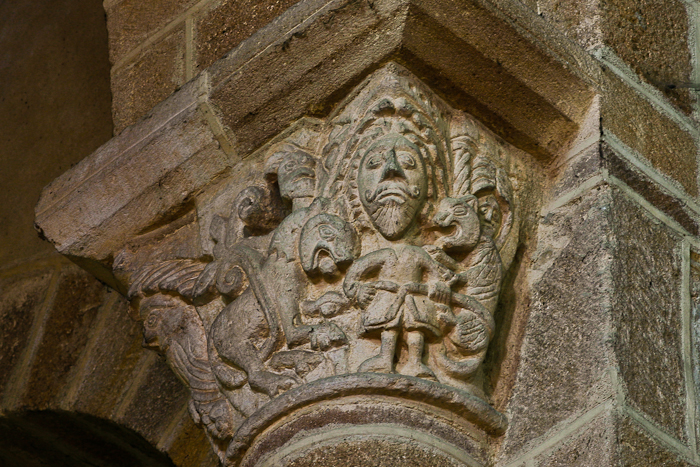
The next shots show a single compelling capital from three different angles. At each corner is a semi-human figure and between any two of them in the face of the capital are birds and animals. The first of these views features a squatting man who appears to be pulling out his own tongue! There is a bird on either side of this enigmatic figure.
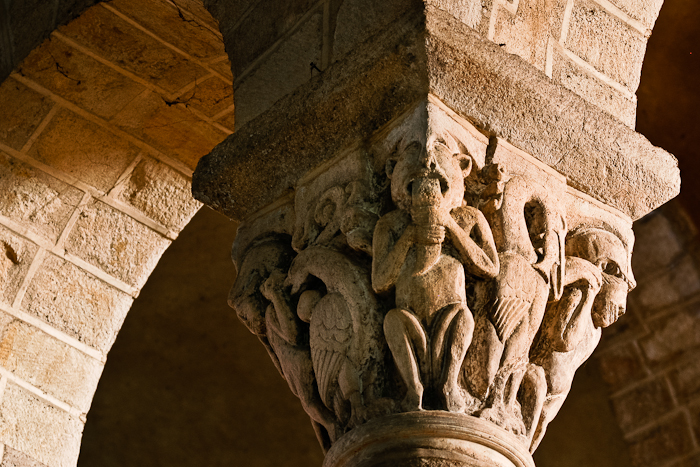
The next view shows the corner figure on the right of the previous shot. A tormented figure supports the vault while a sharp-toothed creature devours his head (PJ refers to these as “head-snackers”). The hands of the creature seem to be pressing down on the shoulders of the man. To his left, a bird eats a fish.
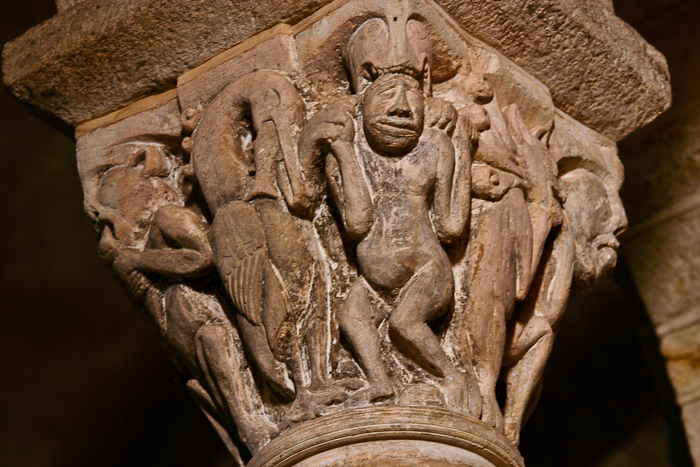
The last view shows a man with a ball in his mouth squatting to hold up the weight of the vaulting above him. His job is made more difficult by a ravening beast chewing on his hand. It is possible that this animal is a lion and the mane flows to the left.
I have tried to determine the meaning of the capital but haven’t succeeded. Because each corner figure appears to be squatting to support the weight of the vault that springs from the capital, there seemed to be a theme of humankind beset by the burdens of life suffering various torments and punishments, while the beasts and birds of the earth who have not been cursed with sin do not undergo these trials. It might also depict sinners suffering eternal punishment in hell. But I don’t really understand the iconography and have not been able to find an explanation in my researches. If anyone can help on this, I would love to hear from you.
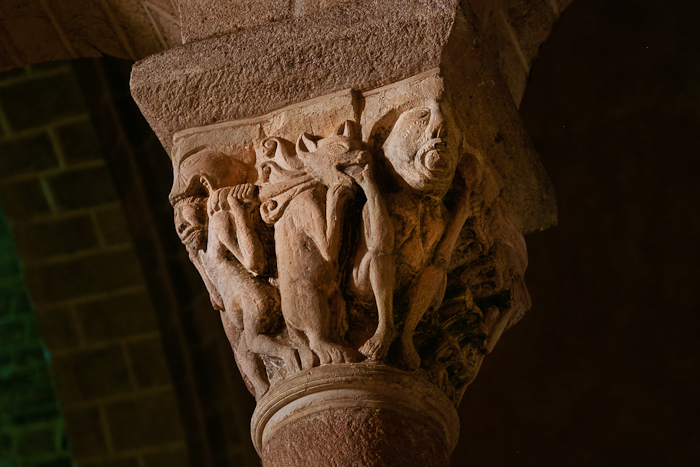
There is an interesting history behind the saint whose name graces the church. The original Saint Genesius was martyred, probably in the year 258, during the eighth persecution under Emperor Valerian. According to tradition, he refused to write a condemnation of Saint Marcel and Saint Anastasius, who were Roman citizens sent by Saint Stephen to preach in Gaul. Genesius was martyred on this site by a judge named Heraclius.
But for years, this Genesius was confused with Saint Genesius of Rome, who was an actor. This Genesius performed in a series of plays that mocked Christianity but he had a conversion experience and was baptised on stage. He refused to renounce his new faith and was executed by Diocletian in 303. It wasn’t until the 18th century that this confusion was rectified. Saint Genesius of Rome, by the way, is the patron saint of both actors and politicians. Interesting.
Location: 46.562081 2.202346

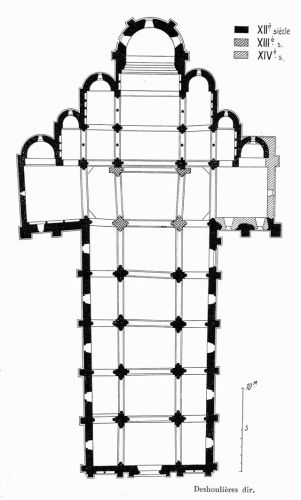
As ever, exquisite photography….and I must say, the light paid you some favours too.
Sue, the light almost always does us favors in these churches. Not always as magically as the apse at Châteaumeillant, but close!
Good!
Great images, it is wonderful the the capitals still have all this wonderful detail.
Janice, we’re working on a post of Saint Pierre d’Airvault this morning – what wonderful capitals there as well. We’ll show a couple.
Dennis and PJ, the lighting is exceptional on these shots!
Sure is, Tom. God-light is a great benefit to us!!
I am interested to know why you decided that the figure with two lions is Daniel and not Samson. My argument in favor of Samson is that the two lions could be the two halves of the lion he tore apart, and there are columns (the columns of the pagan temple?) behind his head, which is again hairy.
Vivian, we had three basic reasons. The first is that in the story of Samson, he was a youth, seeking out his first wife. He did indeed rend the lion in two, but this figure seems clearly to be a mature man. Second, the iconography of the capital has several suggestions; the lion on the left appears to have the bread of Habakkuk in his mouth, there seems to be a figure of Baal above and to the left, and finally, the figure on the far right with the fearful expression might be one of Daniel’s accusers who was subsequently thrown into the lions’ den and devoured. So we are not positive, but it seems to fit. And subsequently, we have heard that this capital is referred to as the “Daniel” capital, but that was after we tried to figure it out. Here is a link to the detailed portioportion of the image
Thank you for the detailed reply. P.S.: please omit the “p” in your spelling of Samson.
Sampson!!!!! Clearly my mind was not on my spelling, even though I got Habakkuk right! Thanks.
I eagerly await your new offerings but I wish you would do a series of just the captials from these churches. As an art historian I am very interested in the sculpture that was done by the average stone mason where he could express himself with a little more latitude than when doing a particular statue. Some of these capitals bely the pagan nature of the original population and the ability of the church to merge both belief systems into one. Please… more capitals
We’ve got a light-hearted presentation on the capitals of the two churches in Chauvigny. Probably tomorrow.
wonderful. I am reading Graham Robb’s book “The Discovery of Middle Earth: Mapping the Lost World of the Celts. and he mentioned the romanesque basilica of St Genes at Chateaumeillant and discusses their wonderful capitals. I found your photos on this church and I wanted more..more… I just love your detailed photos of those small, usually overlooked parts of these masterpieces. Thank you so much.
Alma, we should do another post on Saint Genes, which is a wonderful church. We are actually a short distance away in Bourges right now (we photograph the cathedral in about an hour!). I would love to return to Chateaumeillant and photograph once again.
Alma, we will be doing many posts on the capitals – I have been photographing so many of them recently in every area of France. At least half of my photos this year are of these sculptures. We use a 400m fixed lens in order to capture the details, and sometimes we see extraordinary details. We shot for the fourth time at Saint Pierre de Chauvigny the other day and saw things that we have missed every other time. The eye can only see so much, I’m afraid, and we miss so much!